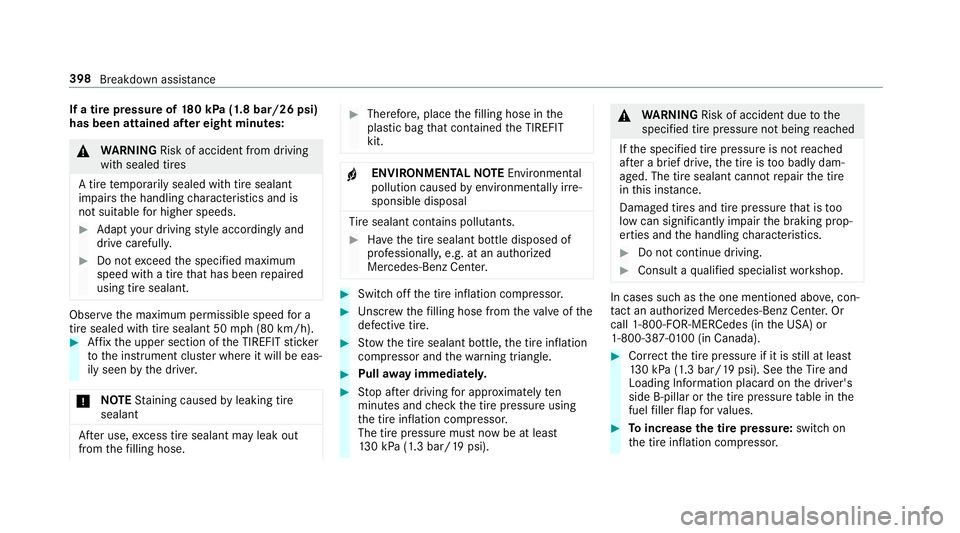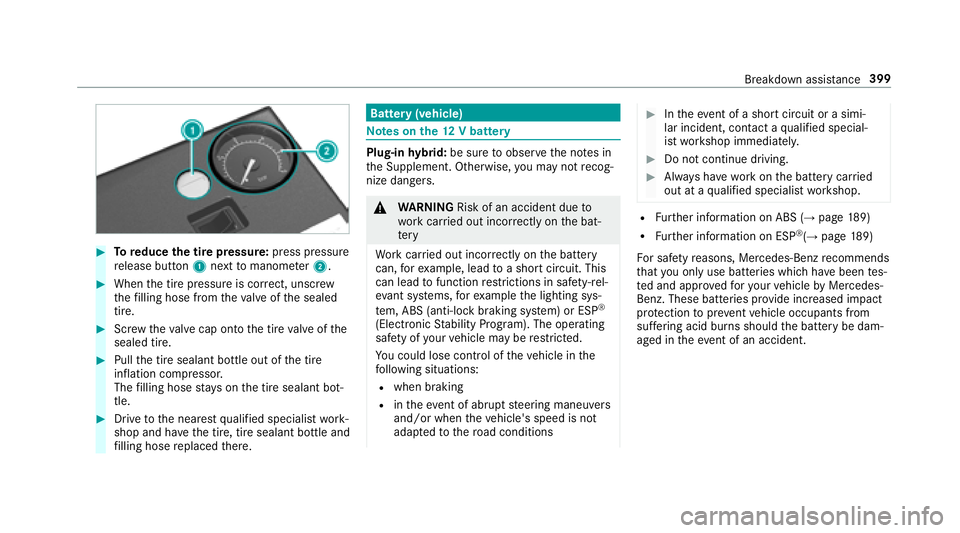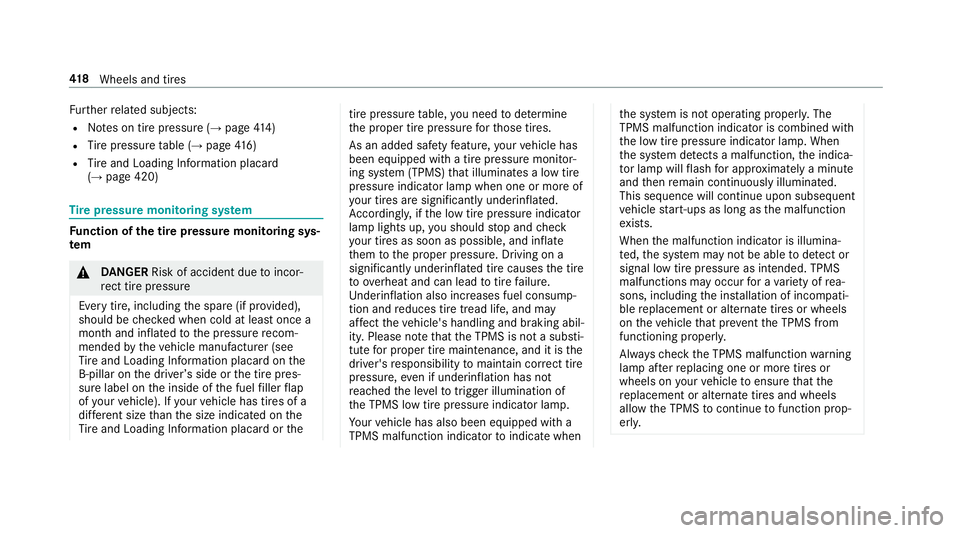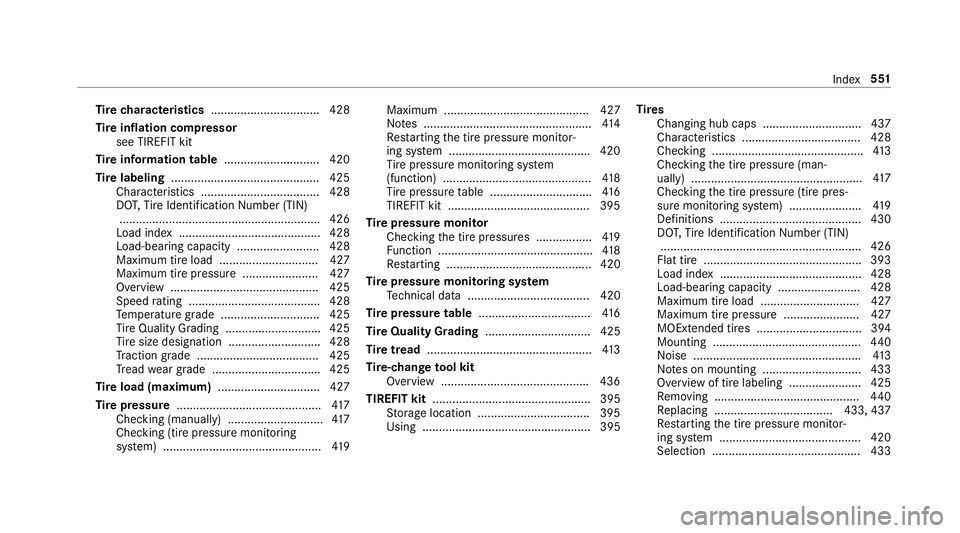2018 MERCEDES-BENZ S-CLASS SEDAN inflation pressure
[x] Cancel search: inflation pressurePage 397 of 562

RIf driving on, observethefo llowing no tes.
Driving distance possible in limp-home mode
af te r the pressure loss warning:
Load condition Driving distance pos‐
sible in limp-homemode
Pa rtially laden 50 miles (80 km)
Fu lly laden 19miles (30 km)
RThe driving dis tance possible in li mp-home
mode may vary depending on the driving
st yle.
RMaximum permissible speed 50 mph
(80 km/h).
If a tire has gone flat and cannot be replaced
with an MOEx tended tire, you can use a stand‐
ard tire as a temp orary measure.
TIREFIT kit storage location
The TIREFIT kit is located under the trunk floor. Mercedes‑AMG
vehicles: observeth e no tes in
th e Supplement. Otherwise, you may not recog‐
nize dangers.
Plug-in hybrid: obser vethe no tes in the Supple‐
ment. Otherwise, you may not recognize dan‐
ge rs.
1Tire sealant filler bottle
2Ti re inflation compressor
Using the TIREFIT kit
Ha ve thefo llowing readily available:
RTire sealant filler bottle
REnclosed TIREFIT sticke r
RTire inflation compressor
RDisposable glov es
Yo u can use TIREFIT tire sealant toseal punctu‐
re s of up to0.16 in (4 mm), particular lythose in
th e tire conta ct surface.You can use TIREFIT in
outside temp eratures down to-4 °F (-20 °C).
&
WARNING Risk of accident when using
tire sealant.
In thefo llowing situations, the tire sealant is
unable toprov ide suf ficient breakdown assis‐
ta nce, as it is unable toseal the tire proper ly:
RThere are cuts or punctures in the tire
lar gerth an those pr eviously mentioned.
RThe wheel rim is dama ged.
RYo u ha vedriven at a very low tire pres‐
sure or on a flat tire.
#Do not continue driving.
#Consult a qualified specialist workshop.
Breakdown assis tance 395
Page 399 of 562

#Pushthe plug of hose 5into flange 6of
tire sealant bottle 1until the plug engages.
#Place tire sealant bottle 1head down wards
into recess 2ofthe tire inflation compres‐
sor.
#Re mo vethe cap from valve 7 onthe defec‐
tive tire.
#Scr ew filling hose 8onto valve 7.
#Insert plug 4into a 12‑V‑sock etinyour
ve hicle.
#Switch on the ignition.
#Press on and off switch 3onthe tire infla‐
tion compressor.
The tire inflation compressor is switched on.
The tire is inflated. Fir st, tire sealant is pum‐
ped into the tire. The pressure may brief ly
ri se toappr oximately 500 kPa (5 bar/73 psi).
Do not switch off the tire inflation compres‐
sor du ring this phase.
#Let the tire inflation compressor runfo r a
maximum of eight minutes.
The tire should then ha veattained a tire
pressure of at least 180 kPa (1.8 bar/26 psi).
If tire sealant leaks out, make sureyou clean the
af fected area as quickly as possible. It is prefera‐
ble touse clean water.
If yo uge t tire sealant on your clo thing, ha veit
cleaned as soon as possible with per chloroe thy‐
lene.
If atire pressure of 180 kPa (1.8 bar/26 psi)
has not been attained af ter eight minutes:
#Switch off the tire inflation compressor.
#Un scr ew thefilling hose from theva lve of the
defective tire.
Please no tethat tire sealant may leak out when
unscr ewing thefilling hose.
#Ve ry slowly drive forw ards or reve rse appr ox‐
imately 33 ft(10 m).
#Pump up the tire again.
Af ter a maximum of eight minutes the tire
pressure must be at least 180 kPa (1.8 bar/
26 psi).
& WARNING Risk of accident due tothe
specified tire pressure not being reached
If th e specified tire pressure is not reached
af te rth e specified time, the tire is too badly
damaged. The tire sealant cannot repair the
tire in this ins tance.
Dama ged tires and a tire pressure that is too
low can significantly impair braking and han‐
dling characteristics.
#Do not continue driving.
#Consult a qualified specialist workshop.
Breakdown assis tance 397
Page 400 of 562

If a tire pressureof180 kPa (1.8 bar/26 psi)
has been attained af ter eight minutes:
&
WARNING Risk of accident from driving
wi th sealed tires
A tire temp orarily sealed with tire sealant
impairs the handling characteristics and is
not suitable for higher speeds.
#Ad apt your drivin gst yle according lyand
drive carefull y.
#Do notexceed the specified maximum
speed with a tire that has been repaired
using tire sealant.
Obser vethe maximum permissible speed for a
tire sealed with tire sealant 50 mph(8 0 km/h).
#Af fix th e upper section of the TIREFIT sticke r
to the instrument clus ter where it will be eas‐
ily seen bythe driver.
* NO
TEStaining caused byleaking tire
sealant
Af ter use, excess tire sealant may leak out
from thefilling hose.
#Therefore, place thefilling hose in the
plastic bag that con tained the TIREFIT
kit.
+ENVIRONMEN TALNO TEEnvironmental
pollution caused byenvironmen tally ir re‐
sponsible disposal
Ti re sealant contains polluta nts.
#Have the tire sealant bottle disposed of
professionall y,e.g. at an authorized
Mercedes-Benz Center.
#Switch off the tire inflation compressor.
#Un scr ew thefilling hose from theva lve of the
defective tire.
#St ow th e tire sealant bottle, the tire inflation
compressor and thewa rning triangle.
#Pull away immediatel y.
#Stop af ter driving for app roxima tely ten
minutes and check the tire pressure using
th e tire inflation compressor.
The tire pressure must now be at least
13 0 kPa (1.3 bar/19 psi).
&
WARNING Risk of accident due tothe
specified tire pressure not being reached
If th e specified tire pressure is not reached
af te r a brief drive, the tire is too badly dam‐
aged. The tire sealant cannot repair the tire
in this ins tance.
Dama ged tires and tire pressure that is too
low can significantly impair the braking prop‐
erties and the handling characteristics.
#Do not continue driving.
#Consult a qualified specialist workshop.
In cases such as the one mentioned abo ve, con‐
ta ct an au thorized Mercedes-Benz Center. Or
call 1-800-FOR-MERC edes (inthe USA) or
1-800-387-0 100 (in Canada).
#Cor rect the tire pressure if it is still at least
13 0 kPa (1.3 bar/19 psi). See theTire and
Loading Info rmation placard on the driver's
side B‑pillar or the tire pressure table in the
fuel filler flap forva lues.
#To increase the tire pressure: switchon
th e tire inflation compressor.
398
Breakdown assis tance
Page 401 of 562

#Toreduce the tire pressure: press pressure
re lease button 1next tomanome ter2.
#When the tire pressure is cor rect, unscr ew
th efilling hose from theva lve of the sealed
tire.
#Scr ew theva lve cap onto the tire valve of the
sealed tire.
#Pull the tire sealant bottle out of the tire
inflation compressor.
The filling hose stay s on the tire sealant bot‐
tle.
#Drive tothe nearest qualified specialist work‐
shop and ha vethe tire, tire sealant bottle and
fi lling hose replaced there.
Bat tery (vehicle)
Note s onthe12 V battery
Plug-in hybrid: be sure toobser vethe no tes in
th e Supplement. Otherwise, you may not recog‐
nize dangers.
& WARNING Risk of an accident due to
wo rkcar ried out incor rectly on the bat‐
te ry
Wo rkcar ried out incor rectly on the battery
can, forex ample, lead toa short circuit. This
can lead tofunction restrictions in saf ety-re l‐
eva nt sy stems, forex ample the lighting sys‐
te m, ABS (anti-lock braking system) or ESP
®
(Elect ronic Stability Program). The operating
saf etyof your vehicle may be restricted.
Yo u could lose cont rol of theve hicle in the
fo llowing situations:
Rwhen braking
Rin theeve nt of ab rupt steering maneuvers
and/or when theve hicle's speed is not
adap tedto thero ad conditions
#In theeve nt of a short circuit or a simi‐
lar incident, contact a qualified special‐
ist workshop immediately.
#Do not continue driving.
#Alw ays ha vewo rkon the battery car ried
out at a qualified specialist workshop.
RFu rther information on ABS (→page 189)
RFurther information on ESP®(→page 189)
Fo r saf etyre asons, Mercedes-Benz recommends
th at you only use batte ries which ha vebeen tes‐
te d and appr ovedfo ryo ur vehicle byMercedes-
Benz. These batteries pr ovide inc reased impact
pr otection toprev ent vehicle occupants from
suf fering acid bu rns should the battery be dam‐
aged in theeve nt of an accident.
Breakdown assist ance399
Page 420 of 562

Further related subjects:
RNo tes on tire pressure (→page 414)
RTire pressure table (→page 416)
RTire and Loading Info rmation placard
(→page 420)
Ti re pressure moni toring sy stem
Fu nction of the tire pressure moni toring sys‐
te m
&
DANG ER Risk of accident due toincor‐
re ct tire pressure
Every tire, including the spare (if pr ovided),
should be checked when cold at least once a
month and inflated tothe pressure recom‐
mended bytheve hicle manufacturer (see
Ti re and Loading Info rmation placard on the
B-pillar on the driver ’sside or the tire pres‐
sure label on the inside of the fuel filler flap
of your vehicle). If your vehicle has tires of a
dif fere nt size than the size indicated on the
Ti re and Loading Info rmation placard or the
tire pressure table, you need todeterm ine
th e proper tire pressure forth ose tires.
As an added saf etyfe ature, your vehicle has
been equipped with a tire pressure monitor‐
ing sy stem (TPMS) that illuminates a low tire
pressure indicator lamp when one or more of
yo ur tires are signif icantly underinflated.
Ac cording ly, if the low tire pressure indicator
lamp lights up, you should stop and check
yo ur tires as soon as possible, and inflate
th em tothe proper pressure. Driving on a
significant lyunderinflated tire causes the tire
to ove rheat and can lead totire failure.
Und erinflation also increases fuel consump‐
tion and reduces tire tread life, and may
af fect theve hicle's handling and braking abil‐
ity. Please no tethat the TPMS is not a substi‐
tute for proper tire maintenance, and it is the
driver's responsibility tomaintain cor rect tire
pressure, even if underinflation has not
re ached the le velto trig ger illumination of
th e TPMS low tire pressure indicator lamp.
Yo ur vehicle has also been equipped with a
TPMS malfunction indicator toindicate whenthe sy stem is not operating properly. The
TPMS malfunction indicator is combined with
th e low tire pressure indicator lamp. When
th e sy stem de tects a malfunction, the indica‐
to r lamp will flash for app roxima tely a minute
and then remain continuously illumina ted.
This sequence will continue upon subsequent
ve hicle start-ups as long as the malfunction
ex ists.
When the malfunction indicator is illumina‐
te d, the sy stem may not be able todetect or
signal low tire pressure as intended. TPMS
malfunctions may occur for a variet yof rea‐
sons, including the ins tallation of incompati‐
ble replacement or alternate tires or wheels
on theve hicle that pr event the TPMS from
functioning proper ly.
Alw aysch eck the TPMS malfunction warning
lamp af terre placing one or more tires or
wheels on your vehicle toensure that the
re placement or alternate tires and wheels
allow the TPMS tocontinue tofunction prop‐
er ly.
41 8
Wheels and tires
Page 553 of 562

Tire ch aracteristics ................................. 428
Ti re inflation compressor
see TIREFIT kit
Ti re information table .............................420
Ti re labeling ............................................ .425
Cha racteristics .................................... 428
DO T,Tire Identification Number (TIN)
.............................................................4 26
Load index ...........................................4 28
Load-beari ng capacity ......................... 428
Maximum tire load .............................. 427
Maximum tire pressure ....................... 427
Overview ............................................. 425
Speed rating ........................................ 428
Te mp erature grade .............................. 425
Ti re Quality Grading ............................. 425
Ti re size designation ............................4 28
Tr action grade .................................... .425
Tr ead wear grade ................................ .425
Ti re load (maximum) .............................. .427
Ti re pressure ............................................ 417
Checking (manually) ............................ .417
Checking (tir epr essure mon itoring
sy stem) ................................................ 419 Maximum ............................................ 427
No
tes ................................................... 414
Re starting the tire pr essure mon
itor‐
ing sy stem .......................................... .420
Ti re pressure monitoring sy stem
(function) ............................................. 418
Ti re pressure table .............................. .416
TIREFIT kit ...........................................3 95
Ti re pressure moni tor
Checking the tire pressures ................. 419
Fu nction ............................................... 418
Re starting ............................................ 420
Ti re pressure moni toring sy stem
Te ch nical da ta..................................... 420
Tire pressure table .................................. 416
Ti re Quality Grading ................................ 425
Ti re tread .................................................. 413
Ti re -change tool kit
Overview ............................................ .436
TIREFIT kit ................................................ 395
St orage location ..................................3 95
Using ................................................... 395 Ti
re s
Changing hub caps .............................. 437
Characteristics .................................... 428
Checking .............................................. 413
Checking the tire pressure (man‐
ually) ................................................ ...
.4 17
Check
ing the tire pressure (tire pres‐
sure monitoring sy stem) ..................... .419
Definitions ........................................... 430
DO T,Tire Identification Number (TIN)
.............................................................4 26
Flat tire ................................................ 393
Load index ...........................................4 28
Load-beari ng capacity .........................4 28
Maximum tire load .............................. 427
Maximum tire pressure ....................... 427
MOExtended tires ................................ 394
Mounting ............................................. 440
No ise .................................................. .413
No tes on mounting .............................. 433
Overview of tire labeling ......................4 25
Re moving ............................................ 440
Re placing .................................... 433, 437
Re starting the tire pressure monitor‐
ing sy stem .......................................... .420
Selection ............................................. 433
Index 551